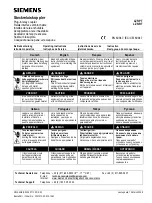
Trip circuit supervision with one digital input and one connected, non-latched trip
output
There is one main difference between non-latched and latched control in trip circuit supervision:
when using the latched control, the trip circuit (in an open state) cannot be monitored as the digital
input is shorted by the IED's trip output.
Figure. 7.4 - 150. Trip circuit supervision with one DI and one latched output contact.
The trip circuit with a latched output contact can be monitored, but only when the circuit breaker's
status is "Closed". Whenever the breaker is open, the supervision is blocked by an internal logic
scheme. Its disadvantage is that the user does not know whether or not the trip circuit is intact when
the breaker is closed again.
The following logic scheme (or similar) blocks the supervision alarm when the circuit breaker is open.
The alarm is issued whenever the breaker is closed and whenever the inverted digital input signal
("TCS") activates. A normally closed digital input activates only when there is something wrong with the
trip circuit and the auxiliary power goes off. Logical output can be used in the output matrix or in
SCADA as the user wants.
The image below presents a block scheme when a non-latched trip output is not used.
A
AQ
Q-S215
-S215
Instruction manual
Version: 2.04
247
Содержание AQ-S215
Страница 1: ...AQ S215 Bay control IED Instruction manual...
Страница 249: ...Figure 7 4 151 Example block scheme A AQ Q S215 S215 Instruction manual Version 2 04 248...
Страница 269: ...Figure 8 13 172 Device installation A AQ Q S215 S215 Instruction manual Version 2 04 268...
Страница 270: ...Figure 8 13 173 Panel cutout dimensions and device spacing A AQ Q S215 S215 Instruction manual Version 2 04 269...
Страница 287: ...10 Ordering information A AQ Q S215 S215 Instruction manual Version 2 04 286...
















































